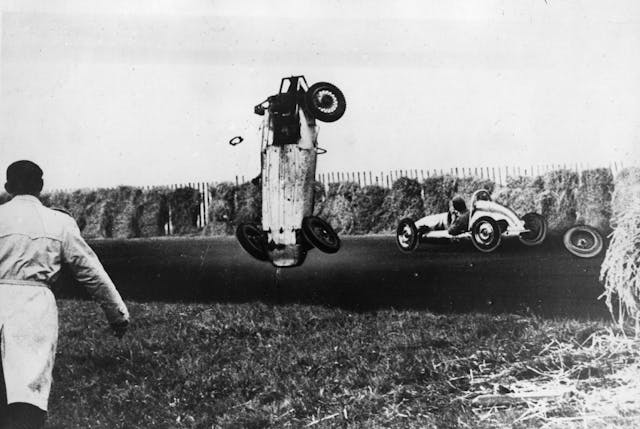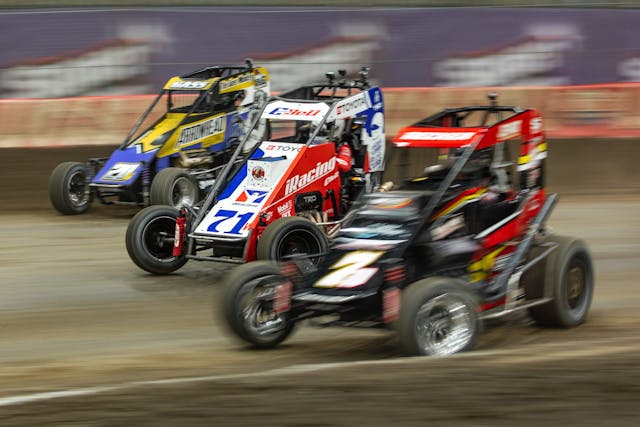Cheap and scrappy, midget racing once ruled American entertainment
When I saw that Larry Webster’s Chili Bowl exploits were going to be featured on this website, I started to think of all the midget races I went to as a kid. My aunt was a total car nut, and she’d take a carload of us kids up to Stafford Springs, Connecticut, to watch the midgets on Friday nights. I also loved going to Riverside Park in Massachusetts with my family. We’d spend the days in the amusement park and watch the races at night.
The first midget race was held June 4, 1933, at the Loyola High School stadium in Los Angeles. It soon became a weekly event there.
Midget racing was relatively affordable and offered real competition. Many drivers built their own cars, which ran all sorts of engines, with the most affordable being old Harley and Indian V-twins, although the Ford V-8/60 was popular, too. Midgets weighed about 700 pounds and had a wheelbase between 65 and 75 inches. With solid axles front and rear, the front engine drove the rear wheels through an in-and-out box. The tiny single-seaters were pushed or towed to start, and sometimes it took a few trips around the oval to fire them up.

Midgets were versatile and could be run on dog tracks, tracks built around baseball fields, fairgrounds, and even indoors. Most tracks were a quarter-mile in length, with a few fifth-mile tracks, although sometimes they’d run on a five-eighths oval like Thompson or on the mile track at Trenton. Surfaces could be dirt, blacktop, concrete, or board, as at New Jersey’s Nutley Velodrome.
In the late 1930s, midget drivers in major markets like Boston and Indianapolis could run up to eight times a week, while in other regions, they could often fit in three to five nights of racing. During the midget’s heyday, Connecticut alone had 31 oval tracks that promoted midget racing, although only four remain. With thousands of venues across America, midget racing was popular, admission was cheap, and regulars got to watch their favorite drivers.

Following World War II, midgets’ popularity continued. Many of the drivers were beloved and had great nicknames: Moe Gherzi was known as “Moneybags Moe” and Duke Nalon was known as “The Iron Duke.” Competition was fiercer than ever, too, thanks in part to the pairing of the Kurtis-Kraft midget and the Offenhauser twin-cam four-cylinder engine, which proved hard to beat. If the Fords were running 60 to 80 horsepower, the Offys had 110. That power drove up the price of a competitive racer, but it helped propel many drivers on to bigger series.
During the 1950s and ’60s, their appeal declined as public interest was often redirected to jalopy racing and more homes got televisions. There were still enough fast Kurtis-Offy midgets out there to attract spectators, although the number of venues and races dwindled.
The oddest race I ever saw was the USAC-sanctioned Formula Libre race at Lime Rock Park in July 1959. There we watched Indy 500 winner Rodger Ward trounce the expensive sports cars on the road course in an 11-year-old Kurtis-Offy midget with a single direct-drive gear. If I weren’t already hooked on midgets, that race did it. It didn’t hurt that there was often a midget in my dad’s shop that I could sit in and pretend.

Midgets were exciting to watch, but they could be dangerous, particularly in the days before full rollcages were required. I distinctly remember my mom covering my eyes when a driver was thrown onto the track.
To this day, I love the midgets. Years ago, I grabbed the opportunity to buy a nice Kurtis-Offy with California racing history, and today it sits on a period trailer pulled by a 1936 Ford pickup truck. I never get tired of looking at the brightly painted machine, which reminds me of all the races I used to watch with my aunt, cousins, and parents. My dreams of racing are long gone, but I can’t wait for my grandson to have a go.


